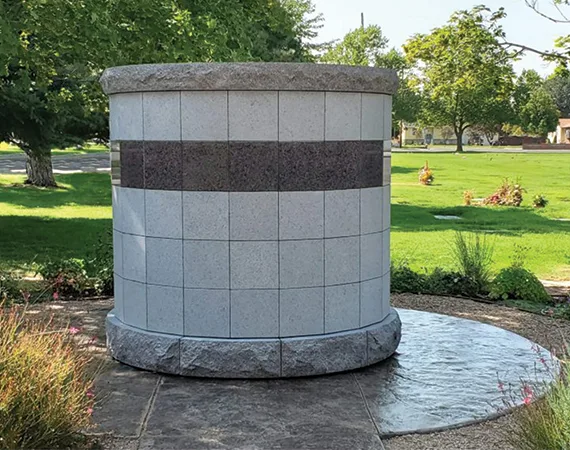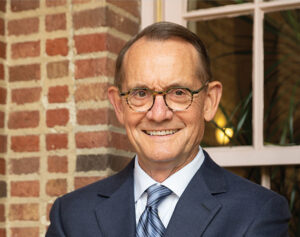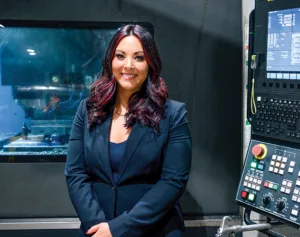When Jack Eickhof designed his first columbarium about 40 years ago, he had no thought of making a business out of his innovative design. His reason for building one was personal.
At that time, Eickhof’s construction business was completing major projects in Minnesota and the Dakotas, from college and university buildings to missile silos. Jack had experimented with a number of construction-related inventions, but after attending a funeral and witnessing the placement of cremains into a monument, he decided to build a memorial structure that could be installed in the First Presbyterian Church in Crookston to hold the ashes of his daughter Gretchen, who had died in a plane crash in 1978.
That columbarium is still the only church-housed memorial for cremains in the city, but today Eickhof Columbaria can be found in almost every U.S. state and in Puerto Rico, Canada, South America, and Australia.
While columbaria were not a new idea, cremation was not as common a choice in the 1980s as it has become today. Jack’s design had stone-covered niches with hidden hardware that could be opened with a special wrench to provide access to the niches for interment. Engraved plaques could be installed with the names, birth, and death dates. On today’s niches the information is usually engraved directly into the granite or other stone.
After Eickhof’s columbarium was installed at the church, his daughter’s ashes were the first to be placed inside. When Jack died in 2020, his ashes were placed next to hers.
Jack’s unique hardware system led to an early patent, but his entrepreneurial nephew Paul wondered if there might be a market for columbaria like the one Jack had built. Paul Eickhof attended a cemetery convention in Nashville where Jack’s design aroused curiosity and interest.
While some of Eickhof’s early columbaria were installed in cemeteries, churches, and other institutions in the 1980s, the business grew faster as cremation became more popular. Today about 60% of the American population choose cremation, and the number continues to grow. While some request that their ashes be scattered, many prefer a permanent resting place and a memorial. It makes ecological sense to inter over 100 cremains in a space that would accommodate only two caskets.
In the 1990s, Eickhof constructed the first free-standing round columbarium and placed it in Crookston’s Oakdale Cemetery. The monument has 64 niches with room for two urns in each — up to 128 cremains — in the space of two regular burial plots. That first monument is now filled to capacity, and last summer a second, larger columbarium was installed at Oakdale.
In the meantime, the business has expanded well beyond Crookston, offering a variety of sizes, shapes, and configurations. About 70% of Eickhof’s projects are customized to meet specific needs. Each project may take several months to complete.
The other 30% use Eickhof Pre-Assembled Modular Columbaria, which can be ordered with a variety of stone options in several colors and finishes.
The business has evolved alongside increased demand. Between 1990 and 1997, the company’s revenues quintupled. In 2012, the company employed 15 people and averaged 40-50 major projects per year. Growth has continued steadily over the past decade, with 75-90 projects per year. Sales increased by 22% between 2021 and 2022. The average size of projects has also increased.
Today more than 1,800 Eickhof Columbaria have been installed across the U.S. and beyond. The company employs 28 people: 23 at the 30,000-square-foot plant in Crookston and five who work remotely.
Charles Eickhof, Paul’s son, describes a relatively new option designed by the company — an ossuarium, which combines the concept of a columbarium with a space for communal interment.
“Inside the unit, there’s a center cavity,” Charles Eickhof explains. “To make use of that center space, we created an ossuary, a vault for the co-mingling of cremated remains [in soft urns]. The unit we fabricated is sort of a hybrid, since it has both the conventional columbarium niches and the inner ossuary portion — hence the term ossuarium, [another option] for providing a dignified memorialization.”
On display in the Eickhof showroom is the Eclipse, or semicircle design. Usually sold in pairs, two Eclipse Columbaria/Ossuaria offer 312 niches (for up to 624 urns) and 540 ossuary spaces, providing a total of 1,164 spaces for cremains in an area that could accommodate four or five coffins.
Guiding a growing company through continuous improvement
Paul Eickhof joined an Enterprise Minnesota Peer Council just before he became the CEO and owner in 2006. “I really never had any peers in business, so when I went to the meetings in Grand Forks it was helpful to hear from other business people about the problems they were experiencing running their businesses and how they solved them,” he says. When Paul stepped off the council a few years ago, Eickhof COO Peter Tollefson took his place.
Amidst the company’s growth, new challenges arise. With the increase in demand, stone and hardware elements are purchased and parts are assembled as project designs come together. Granite comes from Barre, Vt., Cold Spring, Minn., Quebec City, Canada; extruded aluminum from Yankton, S.D.; cement board from Finland; and other materials from other sources, leaving Eickhof’s warehouse in a constant state of flux.
The company recently worked with Ally Johnston, a business growth consultant at Enterprise Minnesota, to involve employees more actively in assessing and solving problems. Johnston says Tollefson wanted to engage the employees actively in continuous improvement.
Johnston led the Eickhof team through a Principles of Lean Manufacturing workshop “to spur ideas and get people thinking and speaking the same language.” She helped participants from the production floor suggest small improvements they could implement on their own, and then generate ideas for larger organizational projects.
The group came up with about 20 ideas, Johnston says. She then ranked them for high customer impact and low effort and cost. Warehouse concerns surfaced as something to be tackled — issues of storing and moving materials safely and efficiently.
Johnston then transitioned to Kaizen and 5S projects. “The group made improvements not only as to how they pick projects and the amount of time it takes to do things, but they also worked through what to do with excess stock (stone/granite) to find the safest, most efficient ways of moving and storing stone,” Johnston says.
Johnston says the Eickhof crew “was very active. Between meetings they were very engaged in doing things outside the actual class, not just going through the motions. They addressed areas that weren’t even part of the scope of the project.”
Tollefson and the Eickhofs will carry on with continuous improvement. Charles says the company has always tried to improve what they do, particularly through refining the hardware and providing design flexibility in their products, which has made them successful. With projected continuous growth and additional focus on small improvements in process, the company will continue to see even more efficient productivity.



